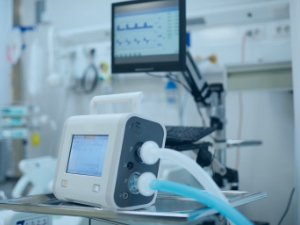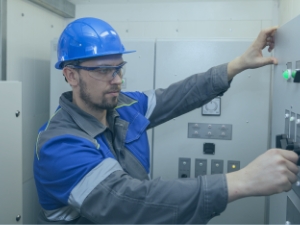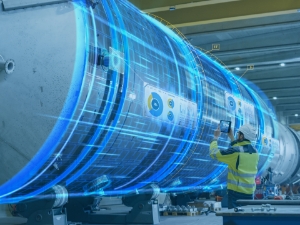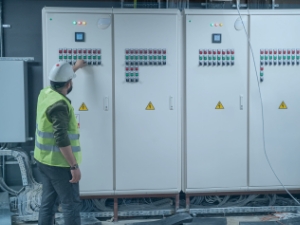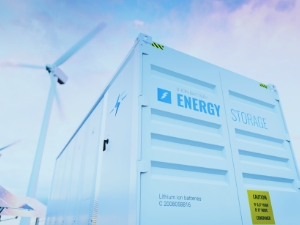An onboard charger (OBC) customer developed a design with a custom power module from a competitor but was dissatisfied with the electrical and thermal performance of the LLC resonant converter’s output stage. Simulation results showed very high peak junction temperatures for some of the silicon die during operation.
Our customer was evaluating a solution for power electronics equipment that required the use of several DC-Link capacitors on the same PCB, while ensuring that the devices would support critical vibration profiles.
Installation and operating reliability are critical objectives for remote applications like wind turbines. With lost energy production and high maintenance costs being major issues for alternative energy applications, engineers continue to prioritize improvements to provide long term reliability to the utility companies that operate these wind farms.
Our customer was evaluating IR receiver modules for a new consumer application design. They required a device that would minimize component counts, costs, and board space requirements, while increasing manufacturability. Furthermore, the module needed to be capable of handling multiple remote control codes between system frequencies of 38 kHz and 56 kHz. However, standard IR receivers are optimized for one frequency, typically 36 kHz or 38 kHz. While they can receive remote control signals for other frequencies, their bandwidth is limited to signals from 26 kHz to 50 kHz, as illustrated by the blue line in the graph below.
As the build-out of clean energy continues, the number of wind turbines deployed continues to increase. In fact, there are nearly 30 000 wind turbines installed in Germany alone (source: BWE Bundesverband WindEnergie e.V.).
Our customer was designing a pulsed application that required a high power 1000 W resistor at high frequencies. Frequent cycling of high power can cause the different materials in the resistor to expand and contract rapidly at different rates. As a result, this thermal mismatch in the coefficient of thermal expansion (CTE) of the various materials can have very destructive effects, including device / system failure.
A customer’s satellite design incorporated a power module that required tight temperature control to ensure the various components included in the circuit performed at an optimal level. To achieve this, heat would have to be transferred from one area of the board to a heatsink, while still having standard RF lines with a TiW / Au metal stack.
The customer’s optical transceiver design required the mounting of a laser diode on a substrate. The accuracy required when mounting this type of component, to ensure the laser output hits the lens and provides optimal performance, is largely unachievable using standard solder preforms and paste, as placement tolerances are very tight and are measured in mils (thousandths of an inch).
Our customer was a manufacturer of hospital ventilators at the outset of the COVID-19 pandemic. Demand for these ventilators increased dramatically as the number of cases rose sharply and the medical industry attempted to respond in a very short timeframe.
The customer’s design engineers faced several constraints when placing a temperature sensing solution in their integrated junction power box. This design required two sensors placed in two different system locations. Functionally, the sensors would control a circuit that reduces current when an abnormal or fast temperature rise is detected.
A customer’s design required a bank of polymer tantalum capacitors to achieve the necessary power level, but was restricted by a limited PCB area. However, the design offered available height that could be used if an appropriate solution could be found.
During an automotive customer’s visit to talk about inductor capabilities, the design engineer explained that they had completed an initial prototype design incorporating a rod inductor for their high current application. They were unhappy with the design’s EMI performance and were looking for ideas to reduce EMI and improve circuit performance.
An aerospace customer required a planar transformer for a high power military avionics application, but did not have the full design specifications finalized. However, it was known that overall board space would be limited, and that the transformer’s height profile would also be a concern.
A customer’s prototype design was developed using the Vishay RH / NH (non-inductive) series of aluminum-housed, chassis-mounted wirewound resistors. These high power resistors are typically used in high power applications that see high pulse energy, especially at start-up.
The customer approached Vishay when their existing panel potentiometer supplier discontinued production of a part used on an established and popular piece of equipment. To avoid a costly redesign, an existing panel potentiometer needed to be adapted to meet the customer’s electrical requirements. It would also have to fit the control panel insertion / retention envelope and existing markings, in addition to the PCB assembly attachment system.
The customer was evaluating technical solutions for a new automotive lithium-ion battery management system. Their two major design objectives were improving circuit efficiency and reducing the size and weight of the measurement and control systems to improve driving range and lower system costs. As this application is still relatively new, there are rapidly evolving innovations that need to be evaluated and potentially included in next-generation designs.
Membrane potentiometers measure mechanical position by elastic deformation of their upper membrane. This position is used in the control loop of an electrical actuator’s motion. In outdoor applications, these membranes can suffer from a memory effect phenomenon when the sensor is in a frozen position caused by exposure to harsh weather conditions, like a mix of temperature and humidity for extended periods. Typically, such conditions affect the membrane and create a permanent deformation that causes future measurements to be inaccurate.


















